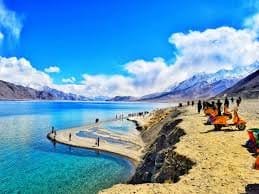
Ladakh’s potential as a hub for India’s semiconductor industry, often compared to Taiwan’s role in the global chip market, stems from a combination of its unique geographical and strategic advantages, though it’s not without challenges. Here’s an exploration of why Ladakh could be significant for India’s ambitions to become a semiconductor powerhouse:
1. Abundance of Raw Materials
Semiconductor manufacturing relies heavily on silicon, derived from sand, and vast quantities of freshwater for cleaning silicon wafers. Ladakh offers access to both:
- Sand: The region’s arid, desert-like terrain, including areas near Aksai Chin, provides a natural source of silica-rich sand, a key ingredient in silicon production.
- Freshwater: Proximity to Himalayan rivers and glaciers, such as those in the Shaksgam Valley or Indus River system, could theoretically supply the massive amounts of ultrapure water needed for chip fabrication. Taiwan, for comparison, has leveraged its water resources effectively, though it has faced shortages during droughts.
While these resources are present, extracting and processing them in Ladakh’s harsh climate and high altitude (over 3,000 meters) poses logistical hurdles, including energy-intensive purification and transportation.
2. Strategic Location and Tactical Depth
Ladakh’s position near the Line of Actual Control (LAC) with China offers strategic depth, which some argue could protect expensive semiconductor foundries from external threats. Taiwan’s chip industry thrives partly due to its defensible island geography, and Ladakh’s rugged terrain could serve a similar purpose. However, this advantage is double-edged—its proximity to a contested border also raises security risks, especially given ongoing tensions with China, a major player in global electronics supply chains.
3. Geopolitical Leverage
India aims to reduce its reliance on imported chips (over 90% currently come from abroad, including Taiwan and China) and position itself as an alternative to Taiwan in the global supply chain. Ladakh could symbolize this shift, aligning with India’s “China Plus One” strategy to diversify manufacturing away from China. Partnering with Taiwanese firms like TSMC or PSMC (as seen in Gujarat with Tata Electronics) could bring expertise to Ladakh, mirroring Taiwan’s own rise as a chip leader in the 1980s through government support and skilled labor.
4. Solar Energy Potential
Semiconductor fabs require uninterrupted power, and Ladakh’s high solar irradiance—among the highest in India—could support renewable energy-powered facilities. With India’s push for green manufacturing, this could lower operational costs and align with global sustainability trends, unlike Taiwan, which relies heavily on fossil fuels for its fabs.
5. Challenges to Overcome
Despite these advantages, Ladakh faces significant obstacles:
- Infrastructure: Taiwan’s success hinges on advanced infrastructure (e.g., Hsinchu Science Park), while Ladakh lacks reliable roads, power grids, and industrial ecosystems.
- Climate: The cold, dry conditions at high altitude complicate construction and operation of fabs, which need precise temperature and humidity control.
- Talent Pool: Taiwan benefits from a highly skilled workforce, whereas Ladakh would need to attract or train engineers, likely relying on India’s broader talent base in cities like Bengaluru.
- Investment: Building a fab costs billions (e.g., Tata-PSMC’s $11 billion Gujarat plant), and Ladakh’s remote location might deter investors compared to established hubs like Gujarat or Uttar Pradesh.
India’s Next Taiwan?
Taiwan dominates advanced chip production (over 60% of the global market, led by TSMC), while India’s semiconductor industry is nascent, focusing on mature nodes (e.g., 28nm chips). Ladakh could play a niche role, perhaps in raw material supply or back-end processes like assembly and testing, rather than rivaling Taiwan’s cutting-edge fabs. India’s broader strategy—seen in the India Semiconductor Mission (ISM) with $10 billion in incentives—prioritizes states like Gujarat (Dholera fab) and Assam, suggesting Ladakh might complement rather than lead this effort.





